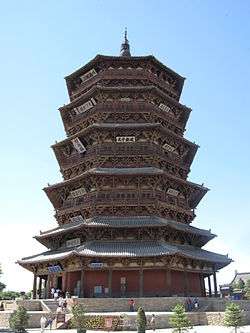Emperor Daozong of Liao
Emperor Daozong of Liao (14 September 1032 – 12 February 1101), personal name Chala, sinicised name Yelü Hongji, was the eighth emperor of the Khitan-led Liao dynasty.
| Emperor Daozong of Liao | |||||||||||||
|---|---|---|---|---|---|---|---|---|---|---|---|---|---|
| Emperor of the Liao dynasty | |||||||||||||
| Reign | 28 August 1055 – 12 February 1101 | ||||||||||||
| Predecessor | Emperor Xingzong | ||||||||||||
| Successor | Emperor Tianzuo | ||||||||||||
| Born | Chala (Khitan name) Yelü Hongji (sinicised name) 14 September 1032 | ||||||||||||
| Died | 12 February 1101 (aged 68) | ||||||||||||
| Spouse |
| ||||||||||||
| |||||||||||||
| Father | Emperor Xingzong | ||||||||||||
| Mother | Empress Xiao Dali | ||||||||||||
| Emperor Daozong of Liao | |||||||
|---|---|---|---|---|---|---|---|
| Traditional Chinese | 遼道宗 | ||||||
| Simplified Chinese | 辽道宗 | ||||||
| |||||||
| Chala (Khitan name) | |||||||
| Chinese | 查剌 | ||||||
| |||||||
| Yelü Hongji (sinicised name) | |||||||
| Chinese | 耶律洪基 | ||||||
| |||||||
Life

Emperor Daozong succeeded his father, Emperor Xingzong, in 1055. He was notable for reviving the name "Great Liao" in 1066, a designation first given the kingdom by Emperor Taizong in 947. Other noteworthy achievements made during his reign include the completion of a Liao edition of the Buddhist Tripitaka and the construction of the Sakyamuni Pagoda in 1056.
Emperor Daozong faced a number of assassination attempts throughout his life. In 1063, a group of Khitans, angry that their system of tribal justice had been put under local Han Chinese administration, ambushed the emperor while he was on a hunting trip. Emperor Daozong survived the attack and the rebels were executed. However, in order to reassert his legitimacy as emperor, he was forced to perform a traditional "rebirth" ceremony. In 1070, he restructured the Liao legal system to reflect the differences in Han Chinese and Khitan customs.
Emperor Daozong's wife, Xiao Guanyin, was said to have been a virtuous woman who would persuade him to be a good leader and to purge corrupt officials. However, Daozong was not interested in ruling the empire and did not take her advice seriously. Xiao Guanyin would stay in her chambers and write poetry to pass the time. A corrupt official by the name of Yelü Yixin (耶律乙辛) feared the influence she had on the emperor and plotted to have her removed. Yelü Yixin conspired with a palace maiden into tricking the empress into writing a love poem. When Xiao Guanyin had finished writing the poem, Yelü Yixin presented the poem to Emperor Daozong, and insisted that the poem contained hidden messages that the empress was having an affair with another man. Emperor Daozong believed Yelü Yixin, and executed the empress in 1075. Yelü Yixin then went on to execute the crown prince and any other officials he did not like. Eventually, Emperor Daozong caught on, and began to take away Yelü Yixin's privileges one by one. Yelü Yixin then attempted to defect to Song, but was caught in the process; he was finally executed in 1083 AD, but the damage he had done to the empire was already done.

Emperor Daozong's reign was fraught with corruption. He spent lavishly on his palaces and his Buddhist worship. Many people under his rule were angered by the high taxes and began to rebel against the Liao dynasty, most notably the Jurchen tribes which would eventually overthrow and replace the Liao dynasty.
Emperor Daozong of Liao House of Yelü (916–1125) Born: 1032 Died: 1101 | ||
| Regnal titles | ||
|---|---|---|
| Preceded by Emperor Xingzong |
Emperor of the Liao Dynasty 1055–1101 |
Succeeded by Emperor Tianzuo |